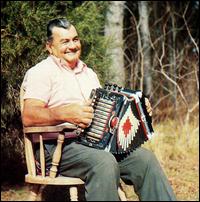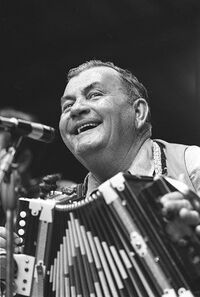Nathan Abshire: Difference between revisions
No edit summary |
No edit summary |
||
| Line 1: | Line 1: | ||
[[File:Nathanabshire2.jpg | 200px | right | thumb |Nathan Abshire]] | |||
==Relevance== | ==Relevance== | ||
{{Page | {{Page | ||
Latest revision as of 11:58, 8 April 2023
Relevance
Mentioned In
- Kill Uncle Tour 1991 Pre-show Tracks
- World Tour 2002 Pre-show Tracks
- World Peace Is None Of Your Business Tour 2014-2017 Pre-show Tracks
- Low In High School Tour 2017-2018 Pre-show Tracks
- Live In Concert 2020 Pre-show Tracks
- Live In Concert 2023 and 40 Years Of Morrissey Pre-show Tracks
Discogs Information
Profile
Cajun accordionist, vocalist and songwriter, born June 27, 1913, between Bayou Queue de Tortue and Gueydan, Louisiana; died May 13, 1981 in Basile, Louisiana.
External Links
Wikipedia Information
 |
Nathan Abshire (June 27, 1913 – May 13, 1981) was an American Cajun accordion player. His time in the U.S. Army inspired Abshire to write the crooner song "Service Blues", which the newspaper Daily World reported as "one of his most memorable tearjerkers". After the war, he settled in Basile, Louisiana, where he played regularly at the Avalon Club. He released his best-known record, "Pine Grove Blues", in 1949. Abshire's music became more well known outside of Louisiana at the 1964 Newport Folk Festival. Abshire was never able to write so he was unable to sign autographs, resulting in him having to politely decline the requests. Despite thoughts of Abshire being "arrogant or stuck-up" for not signing autographs, he was unable to read and write. However, Abshire was taught how to write his own signature by Barry Jean Ancelet. Despite receiving more income from music than the majority of Cajun musicians, Abshire was not able to entirely depend on that income to live on. Abshire had multiple jobs during his life and his final job was working as the custodian of the town's dump. Abshire's legacy continued after his death in the form of a museum, a book, and a magazine special issue. After Abshire's wife declined to have his accordion on display at the Smithsonian Institution in 1983, the accordion was displayed at the Cajun Music Hall of Fame in Eunice, Louisiana in 1996. In 1984, a book titled The Makers of Cajun Music featured Abshire among the musicians. Abshire's former home was made into a renovated museum while also being moved to nearby Basile City Hall. In 2013, the fall edition of the magazine Louisiana Cultural Vistas had 8 pages about "Abshire's life, his love, and his music".
